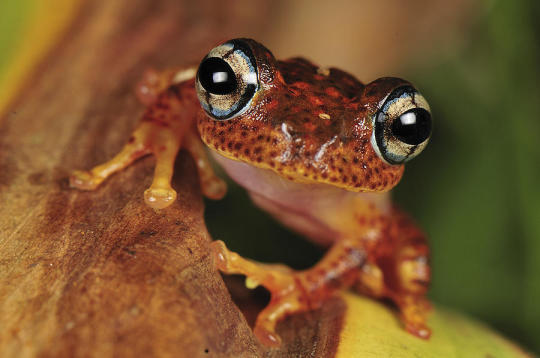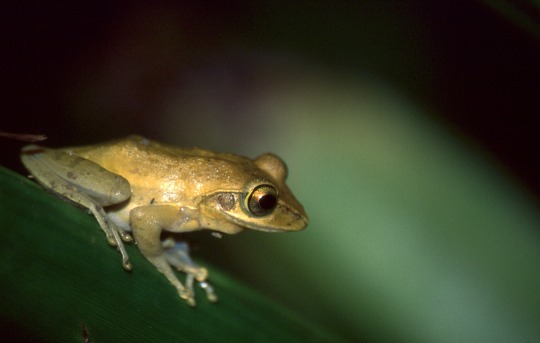#Boophis tephraeomystax
Explore tagged Tumblr posts
Text
frog of the day :)
Boophis tephraeomystax, common names: Mantellid bright eyed frog, Dumeril’s bright eyed frog

(Image source)
Habitat: Subtropical/tropical forests or shrublands, moist savannas. Live around areas with water, such as marshes or rivers.
Found in: Madagascar

(Image source)
#frog of the day#Boophis tephraeomystax#FAMILY: Mantellidae (Mantelid frogs)#mantelid frogs#non-true tree frogs#GENUS: Boophis (bright eyed tree frogs)#bright eyed tree frogs
51 notes
·
View notes
Text
Blommersia transmarina
Boophis nauticus
As a result of their highly permeable skin, frogs are not exactly great at crossing oceans. A few species are able to reproduce in brackish water, but for the most part, salt water is a pretty strong barrier to frogs. Yet, curiously, there are a few islands across the world on which frogs do occur natively (and many many more that have subsequently been colonised by the likes of Eleutherodactylus coqui through the international plant trade). Volcanic islands in particular are fascinating cases, because they are typically very short-lived (think succession of the famous volcanic hot spots of the Galapagos and Hawaii). There are not a lot of examples of volcanic islands that have frogs on them, but each case that does exist may be a recent transoceanic dispersal, and an opportunity to learn a little more about how frogs do make such long-distance dispersals.
The frogs of Mayotte, an island belonging to France that sits between Madagascar and Mozambique in the Mozambique Channel, are one such example. The island of Mayotte is quite small at just 374 km2, and is the south-eastern most island in the Comoros Archipelago, consisting of four islands altogether. The two frog species present on the island, depicted above, were originally thought to be introduced species, but Vences et al. (2003) showed that they in fact represented undescribed species belonging to Madagascan genera, and were evidence for relatively recent trans-oceanic dispersal. They were members of the genus Boophis (tree frogs from Madagascar) and Blommersia (more terrestrial or bush-dwelling frogs).
Now, sixteen years after that initial revelation, the frogs of Mayotte have finally been named. Glaw et al. (2019) described them as Boophis nauticus and Blommersia transmarina, respectively, in the journal Science of Nature (formerly Naturwissenschaften).
These two frogs are the only members of the family Mantellidae—a group of more than 200 named frog species—not endemic to Madagascar. Both indeed fall clearly within Madagascan genera. This in itself is not so surprising; most of the Comoroan herpetofauna has a Madagascan origin, including its geckos, snakes, and skinks. Instead, two things make this stand out as particularly interesting: (1) these are frogs indisputably crossing several hundred kilometres of ocean, and (2) it is not one species that colonised the island and diversified, but instead two, unrelated frogs that independently undertook this journey. Mayotte is also the only island in the archipelago to have frogs on it, for which I am not aware of any clear explanation.
In April 2019, while I was sitting on the island of Nosy Be just off the northwest coast of Madagascar, Cyclone Kenneth brewed up to the north. This was to be the strongest cyclone to hit Mozambique since records began, and was exceptional also in hitting the north of that country. Its path led it past Madagascar’s northern tip and through the Comoros, on its way to make landfall on the east cost of Africa. As I sat in the bungalow, watching the waves beat at the shore and the rain lash the thatched roof over my head, it occurred to me that a storm like this one, maybe a little stronger, maybe reaching its zenith a little further east and passing a little closer to Madagascar’s northern tip, might easily blow vegetation bearing frogs and tadpoles out to sea, and drive them toward the Comoro archipelago.
Such a perfect storm would be extremely rare, and such an occurrence happening to send one or more frogs out to sea still less likely, but given the annual cyclone season, and a time-frame of millennia, even such improbable events tend toward inevitability. And so it seems to have been, for it does appear to have happened twice, from the same area of Madagascar to the same island. Glaw et al. (2019) argue that these two frogs in particular belonged to groups that are amongst the most likely to become swept out to sea and subsequently establish on a volcanic island—their closest relatives, Blommersia wittei and Boophis tephraeomystax + B. doulioti, occur at relatively low elevation, and in fairly arid habitats. The Madagascan Boophis species in particular amongst the most often seen by tourists, because they have a predilection for toilets and showers.
Blommersia wittei from Montagne d’Ambre
Boophis tephraeomystax from Montagne d’Ambre
Interestingly, while B. nauticus strongly resembles its closest Madagascan relatives, Bl. transmarina looks rather different from its mainland sister species, B. wittei, resembling rather some species of Gephyromantis. It is, for example, much larger than other Blommersia species and does not have the characteristically elongated snout. Glaw et al. (2019) discuss the possibility that this may be related to ‘a moderate form of island gigantism’. Whatever the cause, the differences among these frogs are quite stark.
Mayotte’s frogs give us first-hand support for the hypothesised origins of other island frog faunas. Despite being clearly young colonisation rates, one of the species has diverged so strongly from its mainland sister as to be hardly recognisable except by its mating habits. Understanding the events following such a change for frogs may help us understand the incredibly diverse frogs of Madagascar, which represent at least four non-human-mediated trans-oceanic dispersals.
References Vences, M., Vieites, D.R., Glaw, F., Brinkmann, H., Kosuch, J., Veith, M. & Meyer, A. (2003) Multiple overseas dispersal in amphibians. Proceedings of the Royal Society of London B, 270, 2435–2442. 10.1098/rspb.2003.2516
Glaw, F., Hawlitschek, O., Glaw, K. & Vences, M. (2019) Integrative evidence confirms new endemic island frogs and transmarine dispersal of amphibians between Madagascar and Mayotte (Comoros archipelago). The Science of Nature, 106, 19. 10.1007/s00114-019-1618-9
Frogs that set sail: Mayotte’s mantellids finally get names! As a result of their highly permeable skin, frogs are not exactly great at crossing oceans. A few species are able to reproduce in brackish water, but for the most part, salt water is a pretty strong barrier to frogs.
14 notes
·
View notes
Text
Don’t forget

Boophis jaejeri

Boophis tephraeomystax

Boophis occidentalis

Boophis marojezensis

& Boophis blommersae

Boophis? Fucking boophis?
35K notes
·
View notes
Photo

Boophis tephraeomystax
...is a species of Mantellid frog which like other members of its family is endemic to Madagascar. B. tephraeomystax typically inhabits sub/tropical dry forests and moist lowland forests, moist savanna, subtropical/tropical moist shrubland, rivers, freshwater marshes, arable land and degraded former forests.
Classification
Animalia-Chordata-Amphibia-Anura-Mantellidae-Boophis-B. tephraeomystax
Image: Diorit
232 notes
·
View notes